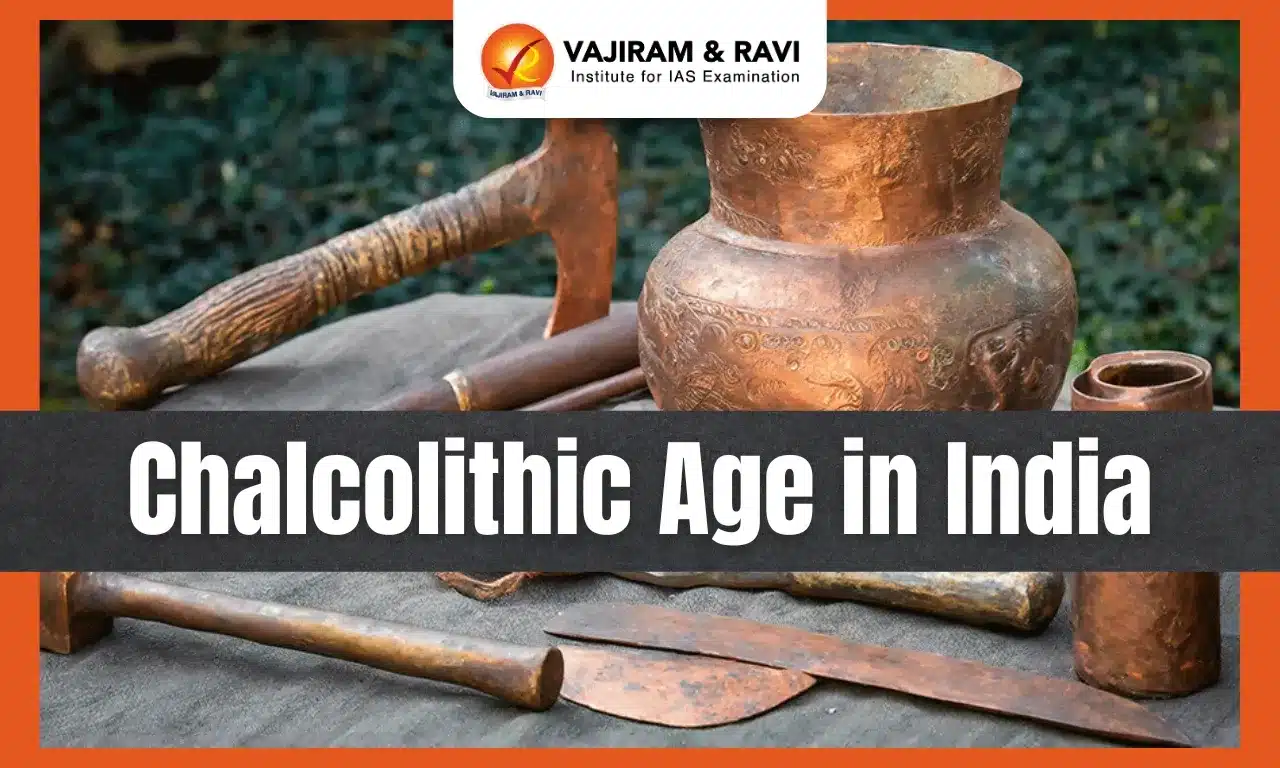Chalcolithic Age in India: Different regions of the Indian subcontinent experienced the emergence of numerous regional cultures by the second millennium B.C., which were distinguished by the use of copper and stone tools. Thus, these societies are known as chalcolithic societies. The Chalcolithic Age is a transitional phase between the Neolithic and the Bronze Age where humans began to use copper as a material for tools and weapons.
Chalcolithic cultures are named based on their location such as Banas culture in Rajasthan, Kayatha culture in Madhya Pradesh and Jorwe culture in Maharashtra.
Chalcolithic Age
This period followed the Neolithic Age and marked the emergence of metal usage, particularly copper and low-grade bronze.
- The Chalcolithic culture, also known as the "stone-copper phase," was characterised by the utilisation of copper and stone and lasted in India from approximately 2000 BC to 700 BC.
- This culture was prominent during the pre-Harappan period but was also present in various regions during the post-Harappan period.
Important Chalcolithic Sites
The largest site of the Chalcolithic period is Daimabad (mainly part of the Jorwe Culture), situated on the left bank of the Pravara River.
Features of the Various Chalcolithic Cultures in India
| Culture Name | Features |
| Ahar Culture |
Also known as the Banas culture, it is one of the earliest Chalcolithic cultures in India. Most sites of this culture are located in the Banas Valley in southeastern Rajasthan, known as Mewar. - Mineral Deposits and Copper Supply:
- Sites and Excavations:
- Phases and Material Culture:
- Settlement Patterns and Industrial Activities:
- Agriculture and Economy:
- Cultural and Ideological Aspects:
- Decline and Termination:
|
| Kayatha Culture |
The culture is named after the chalcolithic site Kayatha, located in Ujjain district, Madhya Pradesh. Most of these settlements are situated along the tributaries of the Chambal River. Its ancient name is Kapitthaka, the birthplace of Varaha, a celebrated astronomer. - Ceramics:
- Tools and Ornaments:
- Lifestyle and Economy:
- End of the Culture:
|
| Malwa Culture |
It is a prominent chalcolithic culture in central India and widely distributed throughout the Malwa region flourished between 1900-1400 BC. - First identified by the excavations at Maheshwar (on the bank of Narmada), which is the ancient Mahishmati. - Malwa culture sites flourished mostly on the banks of the tributaries of Narmada. - Settlement Patterns:
- Structures and Artifacts:
- Expansion:
- Chalcolithic diet:
- Material culture:
- Religious beliefs:
- Decline and Interpretation:
|
| Jorwe culture |
is the most important chalcolithic culture of Maharashtra, spanning almost all of the state except for the coastal strip and Vidarbha. - Regional Centers:
- Types of Sites:
- Subsistence Patterns:
- Material Culture:
- Burial Practices and Religious Beliefs:
- Decline:
|
| Ochre Coloured Pottery Culture |
OCP pottery with larger fragments has been discovered at sites in the upper Ganga-Yamuna Doab. Key Sites were Ahichchhatra and Jodhpura (the only sites where the habitational deposit of the OCP has been found). - Association with Copper Hoards:
- Development of OCP:
|
| Painted Gray Ware (PGW) Culture |
Painted Grey Ware (PGW) is a high-quality grey pottery with a thin fabric and sophisticated firing techniques. - Geographic Distribution:
- Culture and practices:
- Iron and Second Urbanization:
|
| Other Related Posts | |
| Prehistoric Period | Indus Valley Civilization Sites |
| Chalcolithic Age | Rakhigarhi |
| Megalithic Culture | Lothal |
| Town Planning of Harappan Civilization | Kalibangan |
Last updated on January, 2026
→ Check out the latest UPSC Syllabus 2026 here.
→ Join Vajiram & Ravi’s Interview Guidance Programme for expert help to crack your final UPSC stage.
→ UPSC Mains Result 2025 is now out.
→ UPSC Notification 2026 is scheduled to be released on January 14, 2026.
→ UPSC Calendar 2026 has been released.
→ UPSC Prelims 2026 will be conducted on 24th May, 2026 & UPSC Mains 2026 will be conducted on 21st August 2026.
→ The UPSC Selection Process is of 3 stages-Prelims, Mains and Interview.
→ Prepare effectively with Vajiram & Ravi’s UPSC Prelims Test Series 2026 featuring full-length mock tests, detailed solutions, and performance analysis.
→ Enroll in Vajiram & Ravi’s UPSC Mains Test Series 2026 for structured answer writing practice, expert evaluation, and exam-oriented feedback.
→ Join Vajiram & Ravi’s Best UPSC Mentorship Program for personalized guidance, strategy planning, and one-to-one support from experienced mentors.
→ UPSC Result 2024 is released with latest UPSC Marksheet 2024. Check Now!
→ UPSC Toppers List 2024 is released now. Shakti Dubey is UPSC AIR 1 2024 Topper.
→ Also check Best UPSC Coaching in India


















